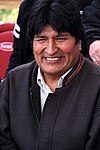Portal:Indigenous peoples of the Americas
Discover Wikipedia using portals
Portal maintenance status: (June 2018)
|
The Indigenous peoples of the Americas PortalCurrent distribution of Indigenous peoples of the Americas The Indigenous peoples of the Americas are groups of people native to a specific region that inhabited the Americas before the arrival of European settlers in the 15th century and the ethnic groups who continue to identify themselves with those peoples. The Indigenous peoples of the Americas are diverse; some Indigenous peoples were historically hunter-gatherers, while others traditionally practice agriculture and aquaculture. In some regions, Indigenous peoples created pre-contact monumental architecture, large-scale organized cities, city-states, chiefdoms, states, kingdoms, republics, confederacies and empires. These societies had varying degrees of knowledge of engineering, architecture, mathematics, astronomy, writing, physics, medicine, planting and irrigation, geology, mining, metallurgy, sculpture and gold smithing. (Full article...) Selected article The Kiowa /ˈkaɪ.oʊwə/ are a nation of American Indians of the Great Plains. They migrated from western Montana southward into the Rocky Mountains in Colorado in the 17th and 18th centuries, In 1867, the Kiowa moved to a reservation in southwestern Oklahoma. Today they are federally recognized as Kiowa Tribe of Oklahoma with headquarters in Carnegie, Oklahoma. The Kiowa language is still spoken today and is part of the Tanoan language family. As of 2011[update], there are 12,000 members. Kiowa call themselves Ka'igwu, meaning "Principal People". Ancient names were Kwu-da and Tep-da, relating to the myth pulling or coming out of a hollow log until a pregnant woman got stuck. Later, they called themselves Kom-pa-bianta for "people with large tipi flaps", before they met Southern Plains tribes or before they met white men. Another explanation of their name "Kiowa" originated after their migration through what the Kiowa refer to as "The Mountains of the Kiowa" (Kaui-kope) in the present eastern edge of Glacier National Park, Montana, just south of the border with Canada. Selected imageGeneral imagesThe following are images from various Indigenous peoples of the Americas-related articles on Wikipedia.
Selected biography Juan Evo Morales Ayma, (born October 26, 1959), popularly known as Evo (Spanish pronunciation: [ˈeβo]), is a Bolivian politician, cocalero activist, and footballer, who has served as President of Bolivia since 2006. Widely regarded as the country's first democratically-elected president to come from the indigenous population, his administration has focused on the implementation of leftist policies, poverty reduction, and combating the influence of the United States and transnational corporations in Bolivia. A democratic socialist, he is the head of the Movement for Socialism (MAS) political party. Born to an Aymara family of subsistence farmers in Isallawi, Orinoca Canton, Morales undertook a basic education before mandatory military service, in 1978 moving to Chapare Province. Growing coca and becoming a trade unionist, he rose to prominence in the campesino (rural laborers) union, campaigning against U.S. and Bolivian attempts to eradicate coca as a part of the War on Drugs, which he denounced as an imperialist violation of indigenous Andean culture. He repeatedly engaged in anti-government direct action protests, resuting in multiple arrests. Entering electoral politics in 1995, he became the leader of the MAS and was elected to Congress. His campaign focused on issues affecting indigenous and poor communities, advocating land reform and the redistribution of gas wealth. Gaining increasing visibility through the Cochabamba protests and gas conflict, in 2002 he was expelled from Congress, though came second in that year's presidential election. Did you know…
SubcategoriesRelated portalsThings you can do
Selected panoramaNative village of Chipitiere, in the Cultural Zone of Manu National Park, Peru image credit: Martin St-Amant Topics
Recognized content
Featured articlesFormer featured articlesGood articles
Former good articlesDid you know? articles
In the News articlesAssociated WikimediaThe following Wikimedia Foundation sister projects provide more on this subject:
American indigenous language WikipediasAvañe'ẽ (Warani) · Aymar aru (Aymara) · ᏣᎳᎩ (Cherokee) · Chahta (Choctaw) · ᐃᔨᔫ (Cree) · ᐃᓄᒃ (Inuktitut) · Iñupiak · Kalaallisut (Greenlandic Inuit) · Mvskoke (Muscogee) · Nahuatlahtolli · Diné bizaad (Navajo) · Qhichwa Simi · Tsêhesenêstsestôtse (Cheyenne) Indigenous languages in Wikimedia Incubators: Alabama · Blackfoot · Chinook Jargon · Choctaw · Creek · Lakota · Micmac · Mohawk · Nheengatu · Northwestern Ojibwa · O'odham · Shoshoni · Unami-Lenape · Wüne pakina (Mapudungun) · Yucatec Maya · Central Alaskan Yup'ik · Zuni | |||||||||||||||||||||||||||||||||||||



